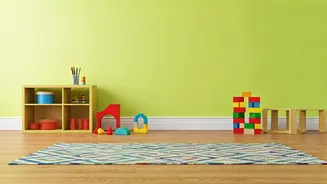Understanding Child Burnout
Children, particularly those in school, are susceptible to burnout, a state of emotional, physical, and mental exhaustion. This often stems from an imbalance
between academic pressures, structured activities, and the need for unstructured play and rest. The pressure to excel academically, coupled with extracurricular commitments, can leave children feeling overwhelmed and stressed. Parents should be aware of the signs of burnout, such as persistent fatigue, irritability, a loss of interest in activities, and complaints about school. Recognizing these signs early is crucial for implementing strategies to help children cope and maintain their well-being. It's essential to understand that burnout isn't simply tiredness; it's a deep-seated depletion that impacts a child's overall health and happiness, requiring careful attention and proactive intervention from parents and caregivers.
Embracing the Kidulting Approach
Kidulting is a parenting philosophy that emphasizes a balanced lifestyle for children, incorporating elements of play, rest, and learning. It involves creating a supportive environment where children can engage in activities they enjoy, take breaks when needed, and approach learning in a less stressful manner. The core idea is to move away from excessive academic focus and rigidly scheduled activities. Instead, kidulting encourages parents to prioritize activities that bring joy and reduce stress. This includes incorporating non-academic days, where children can engage in free play, explore their interests, and simply relax. It promotes a flexible and adaptable approach to parenting, where parents are attuned to their children's needs and provide them with the space and support to thrive in all aspects of their lives. This can involve anything from playing games together, reading books, or even simply enjoying quiet time outdoors.
Non-Academic Days Explained
Non-academic days are a critical component of the kidulting strategy. These are days deliberately set aside where the focus shifts away from traditional schooling and homework. The primary aim is to allow children to de-stress, recharge, and pursue activities purely for enjoyment. Non-academic days can include a wide range of activities, such as playing games, engaging in creative pursuits like art or music, spending time outdoors, or simply relaxing at home. The key is to allow children to choose activities they genuinely enjoy without the pressure of performance or grades. This provides a break from the constant demands of the school environment, enabling children to recover mentally and emotionally. Such days can also be used for family time, where parents and children can connect through shared activities and strengthen their bonds. Implementing regular non-academic days is a practical way to combat the pressures of academic life and foster a healthier and happier childhood.
Importance of Play and Rest
Play and rest are fundamental to a child's overall well-being and are crucial aspects of the kidulting approach. Play provides a natural outlet for children to express themselves, develop social skills, and explore their creativity. It's through play that children learn to navigate challenges, negotiate with others, and develop problem-solving abilities. Parents should ensure that children have ample opportunities for unstructured play, allowing them to follow their interests and imagination. Rest, on the other hand, is equally important. Adequate sleep and downtime are essential for a child's physical and mental health. Children need time to recharge their batteries, process their experiences, and prepare for new challenges. Creating a balanced routine that incorporates both play and rest is essential for preventing burnout. This can involve setting aside dedicated playtime each day and ensuring that children get enough sleep. By prioritizing these elements, parents can help their children maintain a healthy balance and thrive in their daily lives.
Integrating Play-Rest-Learn
The play-rest-learn framework is at the heart of the kidulting philosophy, representing a holistic approach to child development. Learning doesn't need to be confined to textbooks or classrooms; it can be integrated into play and rest. Parents can incorporate educational elements into fun activities, such as board games that involve problem-solving or reading books that spark curiosity. Rest periods can be used for quiet activities like listening to stories or engaging in creative pursuits. The key is to create an environment where learning feels natural and enjoyable, rather than a chore. By blending these three elements, parents can foster a love of learning and provide a balanced foundation for their children's growth. This approach recognizes that children learn best when they are engaged and relaxed, making it easier for them to absorb information and develop a lifelong love of learning. It's about seeing the world as a classroom, and every experience as an opportunity to learn and grow.
Preventing Parent Burnout
Just as children can experience burnout, so can parents. The demands of balancing work, household responsibilities, and childcare can be overwhelming. To prevent parent burnout, it's essential to prioritize self-care and seek support when needed. Parents should take time for themselves, engaging in activities they enjoy, and ensuring they get enough rest and relaxation. Building a strong support system, whether it's through family, friends, or other parents, can provide a much-needed outlet for stress. Communication is key; parents should openly discuss their feelings and concerns with their partners and, if necessary, seek professional help. Recognizing the signs of parent burnout, such as chronic fatigue, irritability, and a feeling of being overwhelmed, is the first step toward addressing the issue. By prioritizing their well-being, parents can better support their children and create a harmonious family environment. This also models for children the importance of taking care of themselves.
Practical Kidulting Tips
Implementing kidulting can be achieved through several practical steps. Create a flexible daily schedule that incorporates non-academic days, playtime, and rest periods. Encourage open communication with your child about their feelings and interests. Involve them in planning activities and making choices. Make learning fun by incorporating games, interactive activities, and real-world experiences. Set realistic expectations for academic performance and celebrate effort and progress rather than focusing solely on grades. Make sure to regularly spend quality time with your child, engaging in activities that both of you enjoy. Build a supportive environment where children feel safe to express their emotions and explore their interests. Regularly assess your child's well-being and adjust your approach as needed. Be patient and adaptable, as every child is unique, and what works for one may not work for another. Kidulting is about building a connection with your children and creating a supportive atmosphere for their overall development.











